|
Hasegawa's
1/32 scale Ki-84 Hayate
in Chinese colors
by
Ian Robertson
|
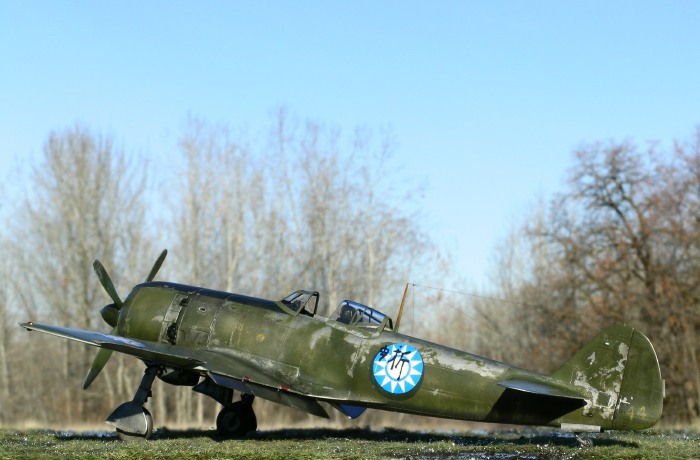 |
|
Nakajima Ki-84 Hayate
(Frank) |

Hasegawa's 1/32
scale Ki-84 is available online from
Squadron.com
The Japanese Army Air Force’s Ki-84 Hayate was one
of the best fighters produced by Japan during WWII. It exhibited
excellent speed, maneuverability, firepower, and defensive armor. After
the war in the Pacific, numerous Ki-84s that had been abandoned by
Japanese units stationed in China and Manchuria were taken over by
Chinese armies, one of which supported Chang Kai-Sheck’s government, the
other Mao Tse-Tung’s communist movement. Both sides employed Ki-84s
during China’s 1946-49 civil war. Those aircraft found near Nanking,
Beijing, or Hankow were taken over primarily by the Kuomintang’s China
Air Force and held in reserve. It is unlikely that they were used much,
if at all, in combat. Those Ki-84s found in Manchuria and northern China
were taken over by the Red Army and used in a ground attack role.

My model represents a heavily weathered aircraft, perhaps a derelict
(but the aircraft seems intact, if not pristine, in the photo I used),
from the Kuomintang China Air Force. Jerry Boucher presents a very nice
color profile of this aircraft in a recent issue of Scale Aviation
Modeller International (Vol 12, Issue 10). The photo and profile served
as the inspiration for my project.
As an interesting side note, a recent discussion over at j-aircraft.com
suggested that the script over the national marking on the port side
reads “Divide China” - a fitting slogan given the turmoil within China
at the time.
Addendum:
After this article was first published, a number
of people from China and elsewhere contacted me regarding the script on
this aircraft.
While their comments differed slightly as to the
exact meaning of the script, most suggest that it indicated the aircraft
was to be dismantled. Given the dilapidated condition of the aircraft in
the photo reference I used, this interpretation seems likely.
Hasegawa’s 1/32 Ki-84 Hayate represents an
excellent offering in this increasingly popular scale. As we have come
to expect from Hasegawa, the model is cleverly engineered, well
detailed, and the fit is superb. The cockpit is a bit clunky (e.g., lots
of the details are molded directly on to the sidewalls), but once it is
put together the cockpit looks quite good.
The only addition I made to the cockpit was a
scratch built seat based on details provided in Aero Detail’s book on
the Hayate.
On the exterior I repositioned the ailerons and
dropped the flaps as they appear in the photo (see above). The control
stick was cocked to the left to reflect the positioning of the ailerons.
I used copper wire for the brake lines.
Cockpit:
I painted the cockpit in bare metal – one of the
color options recommended on j-aircraft.com – using Alclad II over
Tamiya fine gray primer. The instrument panel was painted scale black.
Washes of Tamiya black and Model Master raw sienna / burnt umber were
used to weather the cockpit.
Exterior
 I
began painting the exterior by priming the entire model with Tamiya fine
gray primer from a rattle can, and then polishing the surfaces smooth
with a micromesh sanding cloth. I painted and masked the yellow ID bands
on the leading edge of the wings. The masks were left on until it was
time to weather the model. I
began painting the exterior by priming the entire model with Tamiya fine
gray primer from a rattle can, and then polishing the surfaces smooth
with a micromesh sanding cloth. I painted and masked the yellow ID bands
on the leading edge of the wings. The masks were left on until it was
time to weather the model.
Alclad II “duraluminum” was used as the base for the natural metal
finish. I did not spend much time altering shades on the bare metal on
the upper surfaces since most of it would be obscured with green paint
later on anyway. On the lower surfaces I used various shades of Alclad
(aluminum, dark aluminum, semi-matt aluminum, duraluminum), and I
applied dark washes of highly thinned Tamiya black acrylic to give a
more natural look to the metal.
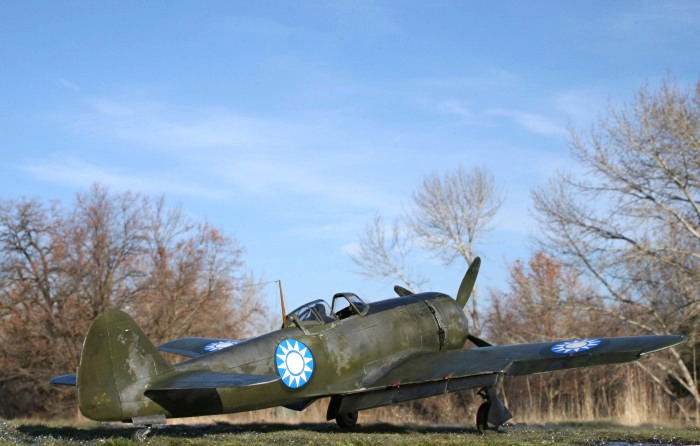
Fabric control surfaces were painted in dull aluminum to represent
silver dope, which was an option on Ki-84s according to my Aero Details
book. From the photograph it certainly appears that the elevators were
shiny where the paint had chipped away.
Prior to painting the green upper surfaces of the model, I brushed on
patches of liquid mask in areas I wanted to remain exposed as bare
metal. In some places the mask was added in large continuous swaths,
whereas in others it was stippled on or added in specific patterns with
a small pointy brush. Efforts were made to match the chipping as seen in
the photo.
Once the liquid mask had dried, I sprayed the upper surfaces of the
model with a mixture of 2/3 Aeromaster Nakajima Army Green and 1/3 Polly
Scale US Olive Drab. I also masked and painted the black anti-glare
panel on the nose and canopy deck.
With the upper surface painting complete, I peeled away the liquid mask
to reveal large areas of bare metal. To further the weathered look I wet
sanded some of the remaining painted surfaces, being careful not to sand
through the layer of Alclad beneath. If I sanded too far I sprayed more
green and repeated. Additional paint chipping was simulated by rubbing a
cotton swab dampened with Tamiya acrylic thinner in strategic places on
the model, and then scraping the softened paint with a toothpick. The
thinner softened the acrylic paint without removing it, and the
toothpick easily scraped the paint away without damaging the Alclad
finish underneath. Note - if you scrape very hard or for too long the
Alcad will show the effects.
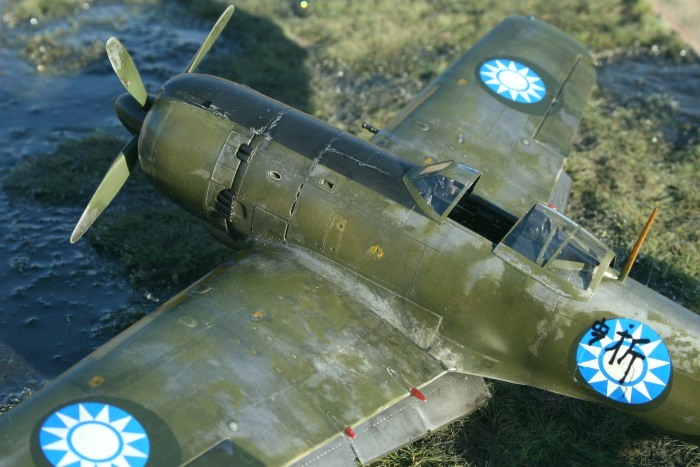
I painted the spinner and propeller blades with Polly Scale RLM 62 over
Alclad II duraluminum. I painted and chipped the yellow tips of the
propeller blades, but relied on the kit’s decals for the thin yellow
warning stripes. I chipped the paint on the rear tips of each propeller
blade using the techniques described earlier.
Finally, I painted the antenna mast brown and then added a coat of
Tamiya clear orange to give it a glossy wooden look. Stretches sprue was
used for the antenna wires.
Markings
I simulated overpainted hinomarus by masking and
painting appropriately-sized dark green disks on the wings and fuselage.
I then applied Chinese markings using EagleCals 1/32 sheets #68-70 (AVG
P-40s). I used the two dark, unfaded, markings provided with each decal
sheet; however, for some reason their colors bleached out in the
photographs.
The Chinese characters on the port national marking were scanned from
Jerry Boucher’s aircraft profile in Scale Aviation Modeller
International, cleaned up in Photoshop, scaled, and then printed on to
Testor's clear decal paper.
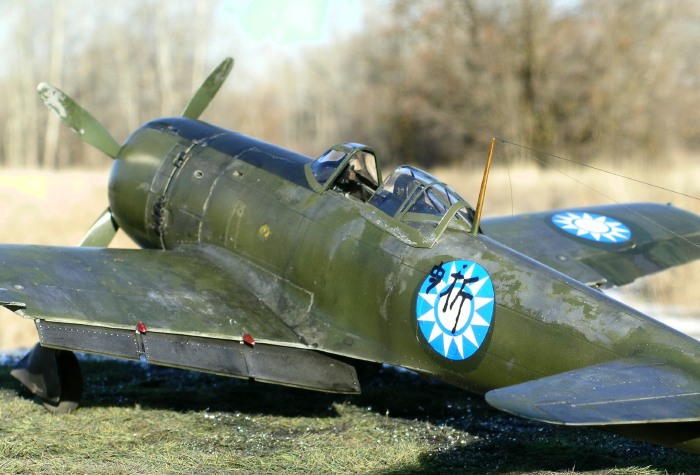
I hand painted the yellow “44” on each side of the rudder and then wet
sanded them to simulate fading. No stenciling was added to the model,
although I did leave a hint of the yellow access hatches on the fuselage
and wings.
Groundwork
A wooden cutting board was used as the base for the
model. Celluclay was used to make the basic ground cover. The celluclay
powder was mixed into a paste with water and white glue, tinted with
dark brown Polly Scale acrylic paint, and then spread thinly over the
cutting board. Note that the cutting board had previously been treated
with several coats of clear lacquer to prevent warping while the
celluclay dried.
While the celluclay was still wet I added pieces of Heki grass mat (item
# 1574 - Wild Grass Savanna) and fine sand. Heki products are now
available for purchase in the United States at “Scenic Express”.
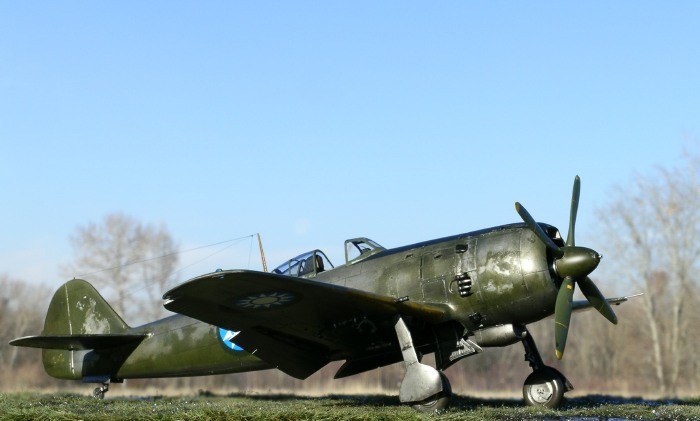
Once the celluclay was dry I used EnviroTex Lite high gloss finish to
simulate puddles. This product is a two part epoxy that dries crystal
clear in 24-72 hours depending on temperature and thickness.
Images of the completed model were taken outdoors in natural light with
a Nikon Coolpix 5400 digital camera. The “unsharpen mask” tool of Adobe
Photoshop was used to restore some of the clarity and crispness lost
during image compression.
Boucher, J. 2006. Scale Aviation Modeller Internatinal, Vol 12(10). Sam
Publications.
Nohara S, and M Tanaka. 1999. Aero Detail #24: Nakajima Ki-84 “Frank”
Hayate. Dai Nippon Kaiga Co.
Wieliczko, L. 2005. Nakajima Ki-84 Hayate. Kagero Monograph #18. Kagero
Publishing.
Click on the thumbnails
below to view larger images:
[../../photogallery/photo00006289/real.htm]
Japanese Army Air
Force Aces 1937–45
Aircraft of
the Aces 13 |
|
|
|
|
US Price: $19.95
UK Price: £12.99
Publisher:
Osprey Publishing
Publish Date:
April
15, 1997
Details: 96 pages; ISBN: 1841762865 |
|
|
Model, Images and Text Copyright ©
2007 by Ian Robertson
Page Created 14 January, 2007
Last Updated 24 December, 2007
Back to HyperScale
Main Page
|
Home
| What's New |
Features |
Gallery |
Reviews |
Reference |
Forum |